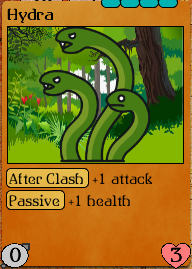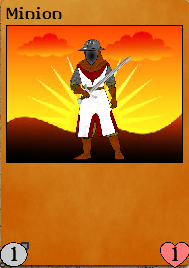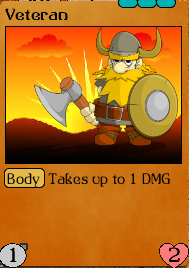Don't Neglect Fun when Balancing
Nothing's better for finding flows than playing your game yourself. Therefore, I often pick up KingClashers with the intention to nitpick to myself about things I don't like. This time, I came across various stuff, such as inelegant placement of certain UI elements and card art I had failed to add transparency to (therefore obscuring their background). In fact, I made enough changes to prompt a minor release shortly after Beta 2. Of course, there are other important stuff that I want to change too, but these require more time.
Leaving aside the technicalities, I want to focus on a minor change I introduced in one of my cards and discuss how balancing originally made the card unplayable.

Previously, its starting health (bottom right) was 2, which stuck me as odd when I reviewed the card; it does not convey a feeling of power compared to other cards in the game, despite the card's attacking capabilities being great. This value was selected to make sure that the card's power level wasn't that pushed. Before discussing why this may not have been a correct decision from a gameplay perspective, I want to explain how it came to be.
As you may know, in KingClashers each turn players select which of their cards clashes with the opponent's selection and those cards permanently damage each other. To balance things out between cards of different power levels, most have a cooldown period where they can't be played for a number of turns. For example, the Hydra has a cooldown period of four turns, which can be seen the blue-ish bars on its top right. Since each deck has a fixed total cooldown of cards that can be placed in it, this also limits the total power level of placed cards.
As an easy guideline to measure the power level of each card, I usually compare them to Minions. Minions have zero cooldown, meaning that they can be played every turn if they survive the clash. More importantly, this allows the player to have any number of them (or of the other zero cooldown cards) in their deck, up to filling their deck size. As a result, minions are usually the building blocks of each deck and at least a quarter of clashes in each game involve minions or other zero cooldown cards of the same power level.

How do I use minions to determine the card's power level and thus assign a suitable cooldown period? As a very rough rule of the thumb, I start by measuring how many Minions each card can effectively trade with and then add some additional cooldown depending on how useful its abilities are - usually I try to design cards so that each of their abilities is worth approximately one minion. For example, let us consider the Veteran.

The Veteran can trade with two Minions and therefore in my mind it starts with two cooldown. I then consider the worth of its ability, which effectively translates to "you need to hit this two time to kill it". This means that the Veteran can be combined with healing-like effects to repeatedly damage cards with high-damage output. Since this versatility essentially establishes a grinding mechanism but is not too powerful by itself, I add to it another point of cooldown. This way, I'm balancing out the fun potential of the card with its cooldown cost to make the card's overall power level average. In general, I try to make most abilities be worth one cooldown so that they are kept interesting.
How do all these relate with the design of the Hydra? Well, they don't - and here lies the problem; the Hydra heals itself while in cooldown, which means that it can effectively trade with any number of Minions. Add to that its ability to become stronger after each clash and it's easy to see that it can eventually become a terrifying threat that is very hard to evaluate on a power scale. Clearly, the opponent's best hope would be to one-shot it, which makes the original two points of starting health an ideal target from a balancing perspective; a lot of the more powerful cards have at least two power.
The thing is, placing only two points of health on the Hydra makes one-shotting it way too easy. This makes it feel fragile instead of this gigantic threat it's meant to be and discourages people from putting the card into their decks for a very simple reason: they must gamble correctly multiple times in order to even start generating value. To understand this, one must understand that the Hydra starts with zero attack (attack is placed on the bottom left of cards) that makes its first and possibly second clashes have little impact in the game's outcome. Furthermore, the player must play cards for four turns until the Hydra is usable again. These cards will also be weaker on average due to including the Hydra (remember that the total cooldown in each deck is limited). And then the opponent will see it coming every time and can prepare accordingly, sometimes soaking up the still-small amounts of damage with their larger threats and sometimes just throwing some fodder under it.
In the end, is this worth it? Perhaps, if the player outplays the opponent and deploys the Hydra at key moments or avoids doing so when it won't yield value. But does the Hydra's health matter for this? Actually no! It only generates a bad feeling if it randomly dies to fodder thrown in front of it. Therefore, the less health is simply unfun on how the card plays. Although it would make matters easier for the opponent, it's also less interesting for them, since it provides them with perhaps too much ways to get rid of a threat and therefore their decisions can feel less important.
In short, a decision that was made to balance out a card ended up hurting the card's playability. I don't know for sure if the new starting health total makes the card alright or pushes it in the overpowered direction, but this can be easily fixed by increasing its cooldown cost if necessary. I'm hesitant to do this though, because this would severely limit the number of types the Hydra can be used in a game and thus the resulting maximum attack it reaches.
Whatever happens, in the end, I think the final version of the Hydra will be a genuinely fun card to play with. And here lies the crux of the matter; while balancing it is important not to remove the reason things are fun.
Get KingClashers
KingClashers
A simple yet deep card game.
| Status | Released |
| Author | maniospas |
| Genre | Card Game |
| Tags | Fantasy, Fast-Paced, PvP, Singleplayer |
| Languages | English |
More posts
- KingClashers - Beta 5.0Mar 06, 2022
- KingClashers Beta 4.0Nov 05, 2020
- KingClashers Beta 3.5Sep 23, 2020
- Quality vs QuantityMar 05, 2020
- Beta 2.2 ChangesApr 09, 2019
- Beta 2 ChangesFeb 15, 2019
Leave a comment
Log in with itch.io to leave a comment.